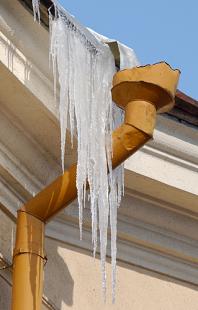Although winter in New England can be mild at times, there are more often than not months that bring heavy snow, cold temperatures and ice dams on your roof. Ice dams are not only a safety hazard for people standing under roof eaves, but they also can damage your roof, and the ice can melt and enter your home.

These dams generally indicate that you may have air leaks in your home's ductwork or sources of air infiltration in your attic. An ice dam occurs when ice forms at the edges of your roof. This tends to happen when the indoor air warms your attic, and causes the snow to melt and collect at the colder edges of the roof. When it melts, it can seep through your roof, even into your home's walls and ceilings, and cause damage.
Consider the following steps you can take for ice dam prevention:
- Clean any debris out of the gutters along the perimeter of your roof. When the melting snow or ice cannot drain, it builds up along the roof, creating the ice dams.
- Inspect any ductwork that runs through your attic. If it's insulated or hard to access, consider contacting an HVAC technician who has the tools and training to find any leaks. If you can access the ducts and find loose connections, use metal tape or mastic sealant instead of duct tape to seal around the pipes, as the adhesive on duct tape is short-lived. If your ducts are fine, add more insulation to the attic floor to prevent warm air from radiating from your ceilings into your attic.
- Verify that enough ventilation exists for the eaves of your roof, so that the temperature outdoors is the same temperature along the edges of the roof. Inspect the insulation next to the edges of the attic, and pull away any insulation that is blocking vents.
If you'd like to learn more about preventing or fixing air leaks that cause ice dams, contact Rodenhiser Plumbing, Heating & Air Conditioning. We serve the Route 495 and 128 area in Massachusetts.
Our goal is to help educate our customers about energy and home comfort issues (specific to HVAC systems). For more information about other HVAC topics, download our free Home Comfort Solutions Guide.
Ice dam image via Shutterstock